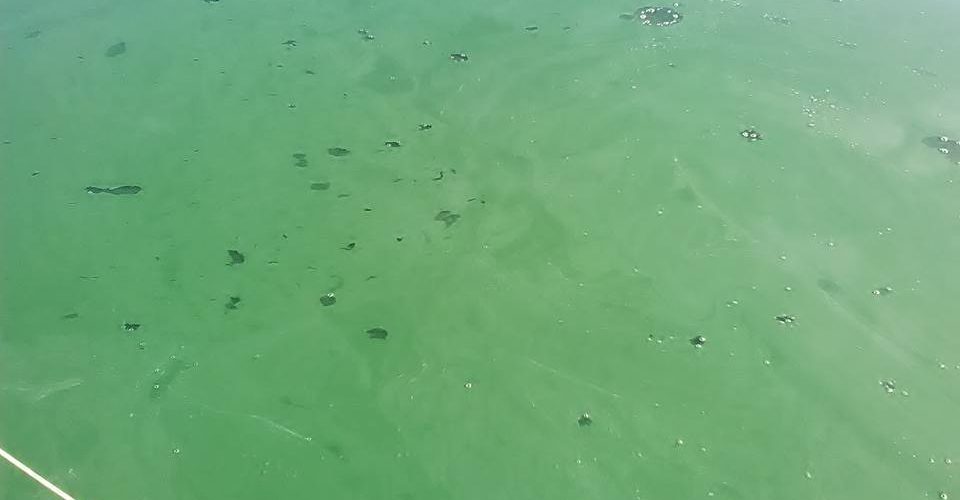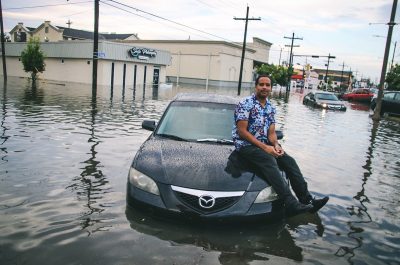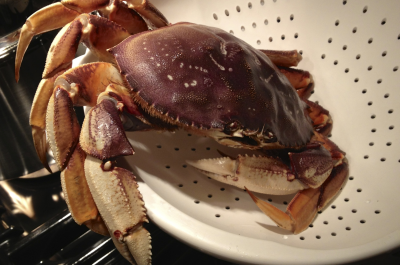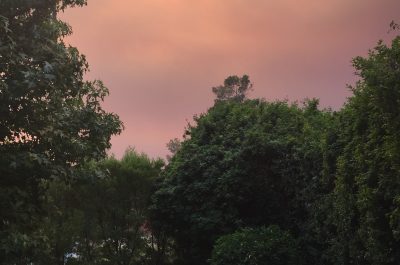It wasn’t just that the water was green. It was vivid green – looking a little like anti-freeze, definitely like Kool-Aid. Fish turned up dead. Crabs, too. And along the road where people usually toss crab nets into the water, a dead gator had beached itself, its light belly a little bloated as it baked in the sun. An algal bloom.
Island Road is all that connects the Isle de Jean Charles to the rest of the parish. It’s the only safe route out in an emergency. Fortified by rock, water still splashes over it whenever there’s a storm surge. It’s been rebuilt before, as storms tend to erode it. The Isle itself has lost 98% of its historic land since the mid-1950s. Which is why the road, and the Isle de Jean Charles itself, have been traveled quite a bit this year, especially by outsiders – ever since the federal government announced that the Isle’s inhabitants had won a $48 million National Disaster Resilience Competition grant to help them relocate.
Local resident Alice Brunet snapped some pictures in late July and August, and shared them in a private Facebook group. Albert Naquin, the traditional chief of the Biloxi-Chitimacha-Choctaw tribe that occupies the Isle is a member of the group. And it was Albert who brought the images here to ISeeChange.
We’ve heard from Louisianans who are wondering: is this dangerous? is this happening more often?
Traditional Chief Albert Naquin sent us these pictures, taken along the Island Road on the way to the Isle de Jean Charles in Terrebonne Parish. “The water was very clear- almost like one was looking through green kool-aid,” said Kristina Peterson. “It was GREEN!” He said he doesn’t know what’s causing it, and locally, people are wondering what is going on.
Is this dangerous?
Right now, the best answer is maybe. Algae blooms aren’t inherently bad. But nobody routinely establishes which kind of blooms are showing up, and little is done to communicate the results.
Alice Brunet and Albert Naquin first reported the bloom to Terrebonne Parish, which says it forwarded the inquiry to the local waterworks. But it’s not really the waterworks’ problem. Mike Sobert, the general manager of the waterworks, said his job is just to turn the muddy Mississippi water from Bayou Lafourche and the salty Gulf water from the Gulf Intracoastal Waterway into something people can drink. As for the body of water around the Isle de Jean Charles, he said, “I got no dog in that hunt.”
But Sobert and others point out that algal blooms appear along the coast, usually where water is slow-moving and shallow, and when it’s hot. Many are unreported: unlike, say, in California or Florida, where beach goers can point them out, Louisiana doesn’t exactly have beaches. And the spaghetti-like warren of lakes, bays, and canals that cuts into the wetlands leaves a lot of shallow, slow water vulnerable to algal blooms.
Some blue-green algae contain toxins that are harmful to fish, gators, and, yes, people. Where cyanobacteria blooms, economic problems can follow – the blooms can clog water infrastructure, and deter tourism. So can health problems.
Louisiana has no systematic statewide testing program for algae. In select spots where algae may threaten oyster beds, Louisiana does weekly testing. But mostly, Louisiana’s best reports of algal blooms come from individuals like Alice Brunet.
Alice’s report made it to the state’s Department of Environmental Quality. A DEQ investigator identified blue-green algae in the water along Island Road. But it doesn’t say what kind of algae were found, or if the water was sampled. The incident is now closed.
Two coastal researchers based in South Louisiana say it’s the right time of year for Anabaena, a kind of cyanobacteria that produces toxins. Both stress that they have only examined the pictures, and neither they nor the local community have taken samples.
Marine ecologist Nancy Rabelais is based in nearby Cocodrie, at the Louisiana Universities Marine Consortium (LUMCON). She thinks the bloom looks like Anabaena and Microcystis. They are toxic to fish, clams, and those that eat them, and it makes people sick if they breathe in any in the air where a boat has gone through the bloom,” Rabelais says. “Taking water samples puts someone at risk as well.”
And Sibel Bargu Ates, an algae specialist at LSU, says, “This could be toxic Anabaena bloom. Usually you cannot do species identification from color but this is the color and time of the year for this species. But we definitely need to look under microscope.”
From the Isle de Jean Charles, Alice Brunet says Louisiana DEQ took a sample. But she doesn’t know the results. “They said its safe to fish, which, I wouldn’t fish in that crap,” she says.
Is this happening more often?
It’s hard to say, at least in Louisiana.
“Louisiana is the only Gulf Coast state that fails to monitor harmful algal blooms, even though this problem is probably on the rise in the hottest year in history,” says Scott Eustis of the Gulf Restoration Network.
Nobody systematically tracks algal blooms’ duration, intensity or location, so it’s hard to say how they change over time – even if we know that one of the conditions they crave – warm temperatures – is more prevelant than ever.
Coastal waters cut up by canals, and estuarine waters around South Louisiana offer haven for cyanobacteria. “We do know that cyanobacteria are a problem [here] because we see them in late summer,” LSU algal specialist Sibyl Ates says. Blue-green algal blooms love shallow, slow-moving or still water, fresh water, and warm temperatures: sounds a lot like late July or August along Island Road to Isle de Jean Charles in Montegut, Louisiana.
The bigger picture for algal blooms in Louisiana is complicated, and dare we say, still a bit murky.
- Fresh water encourages algae growth. The operation of the Mississippi River, its flows and sediment used in restorations, means that fresh water can pulse into the estuarine part of South Louisiana at varied times. If the flows come earlier in spring, fresh water may influence helpful algae growth that can be a source of food for marine life. So scientists and others interested in coastal restoration may consider that when doing their work.
- Extreme weather limits algae growth. Cyanobacteria don’t like to be disturbed. When there are more storms, there’s less algae.
- Warmer sea surface temperatures help algae thrive…
- But ocean acidification may slow them down. And the chemistry of the ocean around Louisiana is likely changing for a bunch of reasons, not just a warming climate. River water influences the near shore as well.
And a bonus question: what about that gator?
It’s a lot to keep track of. But LSU’s Sibyl Ates says it’s worth it. To the people of the Isle de Jean Charles, and Terrebonne Parish, she says, “They did the right thing, reporting and taking pictures, and staying away from the area especially when they see dead animals around. The more alarms these agencies get, I think they’re going to pay more attention.”
After we posted Alice and Albert’s observation, we had a lot of people point out that the gator’s tail looked like it had been cut off, potentially by a poacher. Louisiana has an alligator management program that permits hunting in-season, which is September. http://www.perc.org/articles/hunting-alligators We don’t know what killed the gator, but if it was a person, it was very likely illegal. ISeeChange believes it’s worth keeping track of what’s looking weird or different or interesting or cool, wherever you are. Share your observations with us and we’ll check them out!
Read the report Louisiana’s Department of Environmental Quality created about this algal bloom:
Incident report for Island Road near Montegut, LA
This story will be updated.




